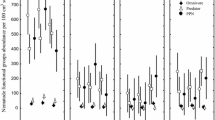Summary
Populations of each developmental stage of three mononchid species (Clarkus, Cobbonchus, Iotonchus) under grazed pasture were estimated in the presence and absence of the earthworm Aporrectodea caliginosa. All stages of all species had signs of prey in their gut. Introduction of earthworms changed the abundance of the species from 158000, 84000 and 2400/m2 to 43 000, 5000 and 41300/m2, but total biomass remained relatively unchanged at 288000 μg/m2. The larger Iotonchus was more abundant in the soil with earthworms and improved texture. The length ratios between the stages of the three species are 1.225, 1.235 and 1.395, with the overall mean of 1.285 close to the value for the Dyar-Hutchinson rule. Other analyses of population separation are made. Given the unequal abundance of the various stages, the species successfully coexist and exploit a wide resource. Predation by such nematodes on bacterial-feeding nematodes may influence bacterial grazing and thus nutrient cycling.
Similar content being viewed by others
References
Alphey TJW (1985) A study of spatial distribution and population dynamics of two sympatric species of trichorid nematodes. Ann Appl Biol 107:497–509
Anderson RV, Kirchner TB (1982) A simulation model for lifehistory strategies of bacteriophagic nematodes. In: Freckman DW (ed) Nematodes in soil ecosystem. University of Texas, Austin, pp 157–177
Chapman SJ, Gray TRG (1986) Importance of cryptic growth, yield factors and maintenance energy in models of microbial growth in soil. Soil Biol Biochem 18:1–4
Christiansen FB, Fenchel TM (1977) Theories of populations in biological communities. Ecol Stud 20:1–144
Haefner JW (1980) Two metaphors of the niche. Synthese 43:123–153
Hines AH (1982) Coexistence in a kelp forest: size, population dynamics, and resource partitioning in a guild of spider crabs (Brachyura, Majidae). Ecol Monogr 52:179–198
Hogue EW (1982) Sediment disturbance and the spatial distribution of shallow water meiobenthic nematodes. J Mar Res 40:551–574
Holter P (1982) Resource utilization and local coexistence in a guild of scarabaeid dung beetles (Aphodius spp.). Oikos 39:213–227
Hopper DJ, Cowland JA (1986) Fungal hosts for the chrysanthemum nematode, Aphelenchoides ritzemabosi. Plant Pathol 35:128–129
Lee KE (1985) Earthworms: their ecology and relationships with soils and land use. Academic Press, Sydney
Petersen H, O'Neill RV, Gardner RH (1985) Use of an ecosystem model for testing ecosystem responses to inaccuracies of root and microflora productivity estimates. Br Ecol Soc [Special Publ] 4:233–242
Polis GA (1984) Age structure component of niche width and intraspecific resource partitioning: can age groups function as ecological species? Am Nat 123:541–564
Small RW (1987) A review of the prey of predatory soil nematodes. Pedobiologia 30:179–206
Stockdill SMJ (1982) Effects of introduced earthworms on the productivity of New Zealand pastures. Pedobiologia 24:29–35
Stout JD (1983) Organic matter turnover by earthworms. In: Satchell JE (ed) Earthworm ecology. Chapman & Hall, London, pp 35–48
Suzuki N (1985) Habitat selection of three chrysomelid species associated with Rumex spp. Oecologia 66:187–193
Yeates GW (1968) An analysis of annual variation of the nematode fauna in dune sand, at Himatangi Beach, New Zealand. Pedobiologia 8:173–207
Yeates GW (1973) Nematoda of a Danish beech forest. II Production estimates. Oikos 24:179–185
Yeates GW (1981) Soil nematode populations depressed in the presence of earthworms. Pedobiologia 22:191–195
Yeates GW (1984a) Helicotylenchus pseudorobustus (Nematoda: Tylenchida) populations changes under pasture during thirty-six months. Pedobiologia 27:221–228
Yeates GW (1984b) Variation in soil nematode diversity under pasture with soil and year. Soil Biol Biochem 16:95–102
Yeates GW (1987) Nematode feeding and activity: The importance of developmental stages. Biol Fertil Soils 3:143–146
Zullini A, Peretti E (1986) Lead pollution and moss-inhabiting nematodes of an industrial area. Water Soil Air Pollut 27:403–410
Author information
Authors and Affiliations
Rights and permissions
About this article
Cite this article
Yeates, G.W. Significance of developmental stages in the coexistence of three species of Mononchoidea (Nematoda) in a pasture soil. Biol Fert Soils 5, 225–229 (1987). https://doi.org/10.1007/BF00256905
Received:
Issue Date:
DOI: https://doi.org/10.1007/BF00256905




